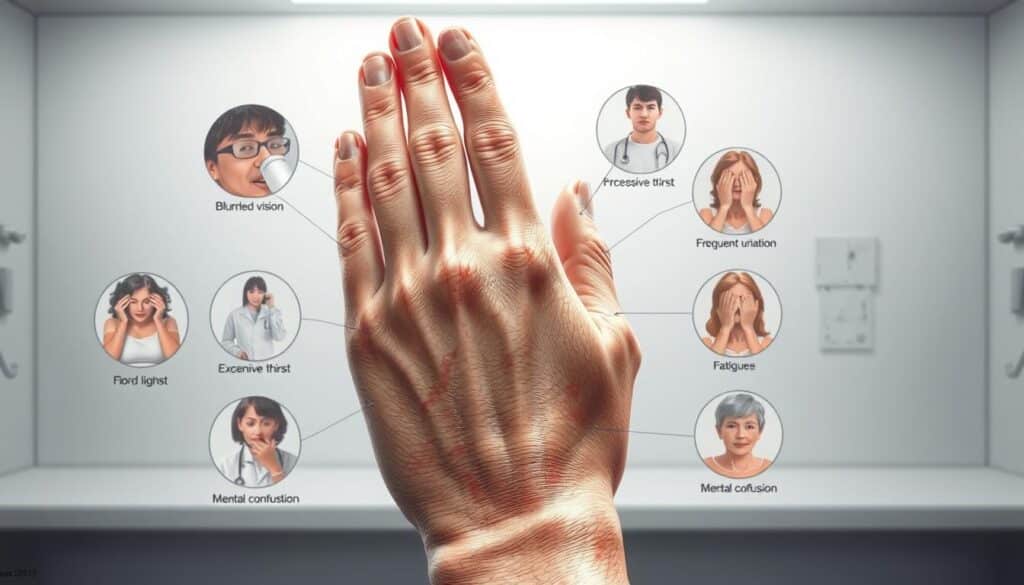Many people don’t realize how closely blood sugar fluctuations relate to head pain. If you’ve ever felt throbbing discomfort after skipping a meal or noticed recurring pressure behind your eyes, your body might be signaling an imbalance.
Research shows extreme highs or lows in glucose levels can trigger tension-type pain. This connection is often overlooked during routine checkups, yet it plays a critical role in managing chronic conditions. For some, persistent discomfort becomes the first clue prompting deeper investigation into metabolic health.
Proper glucose regulation isn’t just about avoiding fatigue or thirst—it directly impacts how your nervous system functions. When levels swing too far in either direction, blood vessels expand or contract rapidly, creating pressure that manifests as head pain.
Recognizing patterns in these episodes helps distinguish ordinary tension from warning signs of underlying issues. Tracking when discomfort occurs—after meals, during fasting, or with specific activities—provides valuable insights for healthcare providers.
Understanding this relationship empowers you to take proactive steps. In the sections ahead, we’ll explore how stabilizing blood sugar influences symptom relief and discuss actionable strategies tailored to your needs.
Understanding Diabetes and Its Impact on Your Health
Energy regulation in your system is more complex than most assume. Diabetes occurs when your body struggles to manage glucose effectively, leading to sustained imbalances. This condition disrupts how cells absorb energy, often due to issues with insulin production or response.
What Is Diabetes and How It Affects Your Body?
Insulin acts like a key, allowing glucose from food to enter cells. Without enough insulin—or if cells resist it—sugar builds up in your bloodstream. Over time, this high blood sugar damages nerves, kidneys, and blood vessels.
Common signs include excessive thirst, sudden weight loss, and fatigue. Dehydration often follows because your kidneys work harder to filter excess glucose. Left unmanaged, these shifts in sugar levels can lead to vision problems or heart issues.
Different Types of Diabetes and Their Key Characteristics
Type 1 diabetes typically appears early in life when the immune system attacks insulin-producing cells. Type 2 develops gradually, often linked to lifestyle factors that reduce insulin sensitivity. Gestational diabetes occurs temporarily during pregnancy due to hormonal changes.
Each type requires unique management strategies. For example, people with Type 1 rely on external insulin, while those with Type 2 may focus on diet and exercise. Recognizing these differences helps tailor treatments to stabilize blood sugar levels effectively.
Can diabetes cause headaches? Unraveling the Connection
Sharp swings in glucose levels act like invisible puppeteers pulling strings in your body. When numbers dip too low (hypoglycemia) or climb excessively high (hyperglycemia), your brain sounds alarms through throbbing discomfort.
Why Fluctuations Spark Pain
In hypoglycemia, your system releases stress hormones like adrenaline to boost glucose. This sudden surge narrows blood vessels, creating pressure that radiates as head pain. Hyperglycemia thickens blood, slowing oxygen flow and triggering inflammation—both linked to persistent discomfort.
Insulin’s Balancing Act
Insulin helps cells absorb sugar for energy. Without enough, glucose accumulates while cells starve. This imbalance stresses nerves and blood vessels, often manifesting as symptoms like dizziness or tension behind the eyes.
Tracking patterns with a glucose monitor reveals triggers. For example, headaches after skipped meals often point to low blood sugar. Consistent spikes post-meals may indicate hyperglycemia. Recognizing these signs early allows adjustments before complications intensify.
Hormones like norepinephrine further strain cranial blood vessels during extremes. Managing stability through regular checks and timely snacks can ease these reactions. Your body’s signals matter—listen closely.
Recognizing Blood Sugar Imbalances: Hypoglycemia and Hyperglycemia
Your body sends clear signals when sugar levels veer off course. Hypoglycemia occurs when glucose drops below 70 mg/dL, while hyperglycemia means levels exceed 180 mg/dL. Both extremes strain your system differently, demanding swift action.

Identifying Symptoms of Low Blood Sugar
Shakiness and sudden sweating often warn of hypoglycemia. You might feel dizzy or confused as your brain struggles with energy shortages. Headaches frequently accompany these episodes, along with irritability or rapid heartbeat.
Signs of High Blood Sugar and Associated Headaches
Hyperglycemia creeps in with blurred vision and excessive thirst. Your kidneys work overtime, causing frequent urination and dehydration. Persistent high levels inflame blood vessels, triggering tension-type discomfort that worsens without treatment.
Insulin acts as your body’s natural stabilizer—without enough, glucose accumulates dangerously. Those with type 1 or type 2 diabetes face higher risks if imbalances persist. Regular monitoring helps catch fluctuations early, protecting long-term health.
Ignoring symptoms risks severe complications like nerve damage or heart disease. Always consult your doctor if patterns emerge. Quick interventions—like glucose tablets for lows or adjusted insulin doses for highs—can restore balance before crises develop.
Lifestyle and Dietary Changes to Prevent Headaches
Small daily choices shape how your body responds to blood sugar shifts. Prioritizing nutrient-rich meals and consistent movement creates a buffer against glucose extremes—and the discomfort they bring.

Implementing a Balanced Diet to Stabilize Blood Glucose
Focus on whole foods like leafy greens, lean proteins, and complex carbs. These release energy slowly, preventing sudden spikes. Swap sugary drinks for water or herbal teas—dehydration often worsens imbalances.
Fiber-rich options like oats or legumes improve insulin sensitivity. Pair them with healthy fats (avocado, nuts) to slow sugar absorption. Track meals in a journal to spot patterns linking diet to symptoms.
Regular Exercise and Monitoring for Improved Health
Physical activity helps cells use glucose efficiently. Aim for 30 minutes daily—brisk walks or cycling work well. Always check levels before workouts to avoid lows.
Consistent monitoring reveals how lifestyle changes affect your numbers. Share data with your doctor to fine-tune medications safely. Sudden adjustments without guidance may trigger side effects like dizziness or fatigue.
Start small: meal prep twice weekly or add a 10-minute walk after dinner. These steps build habits that protect against common causes of instability while improving your overall condition.
Treatment Options for Managing Diabetes-Related Headaches
Effective management of glucose-related discomfort involves both immediate relief and long-term strategies. While over-the-counter solutions offer quick fixes, they work best when paired with personalized care plans addressing root causes.
Over-the-Counter Pain Relief and Medication Considerations
Medications like acetaminophen or ibuprofen temporarily ease pain caused by blood vessel changes. However, always check with your doctor before use—some may interact with insulin or other drugs. For those with type 1 or type 2 diabetes, timing matters. Take pills with food to avoid stomach irritation during blood glucose swings.
Chronic use of NSAIDs can strain kidneys already stressed by high sugar levels. Track frequency: if you need painkillers more than twice weekly, it’s time to reassess your approach. Prescription options like triptans help migraine sufferers but require careful dosing adjustments.
When to Consult Your Healthcare Provider for Persistent Symptoms
Headaches that linger despite stable lifestyle changes could signal underlying conditions. Sudden vision changes or confusion alongside head pressure demand urgent attention. Your care team might order tests to rule out neuropathy or cardiovascular issues common in people diabetes.
Collaborate to refine insulin regimens or explore alternative therapies. For example, magnesium supplements show promise in reducing nerve-related discomfort. Remember: lasting relief stems from partnership, not quick fixes alone.
Integrative Approaches to Managing Diabetes and Headache Triggers
Managing chronic conditions requires more than medication alone. Combining traditional treatments with holistic strategies addresses both physical and mental factors influencing your health. This dual approach helps stabilize glucose while reducing triggers for discomfort.
Stress Reduction Techniques and Their Benefits
Chronic stress activates your brain‘s fight-or-flight response, releasing hormones that spike glucose levels. Over time, this worsens insulin resistance and creates a cycle of metabolic problems. Mindfulness practices like deep breathing interrupt this pattern by calming your nervous system.
Try progressive muscle relaxation or guided meditation for 10 minutes daily. Yoga combines movement with breathwork, improving circulation and reducing tension. Studies show these methods lower inflammation markers linked to head pain.
Regular check-ups with healthcare providers ensure you address a range of symptoms early. Blood tests can reveal nutrient deficiencies that amplify stress responses. Supplements like magnesium or B vitamins might complement your plan.
Watch for subtle signs like irritability or fatigue—they often precede bigger imbalances. Proactive stress management reduces your risk of complications by keeping both mind and body in sync. Pair these strategies with medical guidance for lasting stability.
Conclusion
Maintaining stable glucose levels plays a pivotal role in preventing recurrent head pain. When blood sugar swings disrupt oxygen flow to cells or strain blood vessels, tension often follows. Tracking patterns through regular monitoring helps identify triggers like missed meals or dehydration.
Adopting consistent habits—balanced meals, hydration, and stress management—supports long-term stability. Early intervention when imbalances occur reduces risks of complications. If discomfort persists despite adjustments, consult your doctor to explore underlying factors.
Proactive care extends beyond symptom relief. By prioritizing blood sugar control, you protect overall wellness while minimizing headache frequency. Keep a log of episodes alongside glucose readings to spot trends faster.
Take action today: Schedule routine checkups and share your observations with healthcare providers. Small, informed steps create lasting impacts on your health journey.
FAQ
How do blood sugar fluctuations trigger headaches?
Rapid changes in glucose levels affect blood vessels and nerves in the brain, leading to tension or migraine-like pain. High or low readings strain the body, causing dehydration, inflammation, or energy shortages that contribute to discomfort.
What are common signs of hypoglycemia to watch for?
Shakiness, sweating, dizziness, confusion, and irritability often signal low blood sugar. Headaches may accompany these symptoms if glucose drops below 70 mg/dL. Immediate treatment with fast-acting carbs like juice or glucose tablets is critical.
Can hyperglycemia lead to chronic headaches?
Prolonged high glucose levels damage nerves and blood vessels, increasing headache frequency. Consistently elevated readings above 180 mg/dL may also cause dehydration, worsening head pain. Regular monitoring helps prevent these complications.
How does insulin resistance influence headache risk?
When cells stop responding properly to insulin, glucose builds up in the bloodstream. This imbalance stresses the body, triggering inflammation and vascular changes that heighten sensitivity to headaches, especially in those with type 2 diabetes.
Are certain headache types linked to diabetes management?
Migraines and tension headaches are more prevalent among individuals with unstable glucose levels. Research shows a 30% higher incidence in people with poorly controlled blood sugar compared to those within target ranges.
What dietary strategies reduce diabetes-related headaches?
Focus on low-glycemic foods like leafy greens, nuts, and lean proteins to stabilize glucose. Avoid processed sugars and refined carbs, which cause spikes. The American Diabetes Association recommends pairing carbs with fiber or protein to slow absorption.
When should someone seek medical help for these headaches?
Consult a healthcare provider if pain persists despite normal glucose levels, worsens with medication, or includes vision changes, vomiting, or confusion. These could indicate emergencies like diabetic ketoacidosis or severe hypoglycemia.
Do stress-reduction techniques aid in headache prevention?
Yes. Chronic stress raises cortisol, which disrupts glucose regulation. Practices like meditation, yoga, or deep breathing improve insulin sensitivity and lower inflammation, reducing both headache frequency and A1C levels over time.


